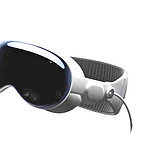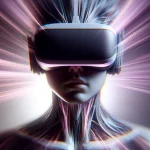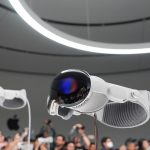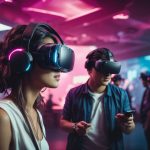

About two months ago, I bought one of the few Apple Vision Pro models in Germany for almost €4,000. Now, after extensive use, I would like to share my experiences and critical observations.
The first experience with the Apple Vision Pro is undoubtedly impressive. The pre-installed demos, such as the impressive, albeit short, "Encounting Dinosaurs", in which dinosaurs break through the walls of the room in a photorealistic manner, show the immense potential of the glasses. The Jig application also offers the option of projecting highly detailed CAD models directly into the living room.
However, as soon as the first waves of enthusiasm subside, the limits of the current software offering become apparent. Apart from a few films in 3D via Disney+, if you have an account, the offer is thin on the ground. A look at the App Store confirms these fears: Many apps are just simple ports of iPad apps - not immersive experiences developed specifically for the Vision Pro.
For a headset that is supposed to allow users to wear the device for a long time and promises more productive work, it is quite heavy at 600-650g. Metas Quest weighs 515g in comparison. In this context the design decision It is also incomprehensible why the front screen of the Vision Pro, which actually only shows the eyes, and its heavy glass cover were integrated into the glasses. These components contribute nothing to the wearer's productivity, but are merely a design gimmick.
The Apple glasses' low battery life of 2 hours seems similarly unpragmatic. This is probably due to the integrated components such as the M2 processor, which originate from the world of laptops and are not based on Snapdragon chipsets optimized for mobile devices, as is the case with other stand-alone VR glasses. This fact probably also leads to the necessity of the external battery packs that users have to carry around with them if they want to operate the Apple Glasses without a power connection. Without this battery, the Apple cannot run as it does not have an internal battery. Here, too, you get the feeling that Apple wanted to boast about performance in order to set itself apart from the competition. They have succeeded, the computing power of the Vision Pro is indeed impressive. However, this comes at the expense of energy efficiency, which is a big minus for the product.
This situation is strongly reminiscent of previous launches of VR products such as the Microsoft HoloLens glasses, the XR glasses for a similarly high price, which suffered from a lack of software support despite advanced technology. The HoloLens also promised spatial computing and was a pioneer for many of the technologies that Apple's glasses are now based on. HoloLens 1 and 2 were never able to reach a wider audience despite innovative technology because there was simply too little software available and the price of the glasses made scaling HoloLens business solutions simply too expensive. Apple, despite its innovative strength and immense resources, seems to have made the same mistake: High-priced hardware without sufficient software support and no "killer apps" that can only be experienced on this platform. It is even noticeable that not even apps that already run on the most successful VR platform, such as Meta Quest, were ported to the Apple glasses before the commercial launch of the Vision Pro product.
Every accessory for the Apple glasses is expensive, from the carrying case and strap to the replacement battery; each part costs around 200$. It seems as if Apple has thought to itself: "If you're already paying that much for a VR headset, money is probably no object anyway." As a user of the Vision Pro, you get the feeling that Apple is excluding you. Apple's approach of selling a customized Vision Pro for up to 500$ extra to eyeglass wearers is not meant to be inclusive but simply upselling.
The challenges for developers are considerable. In addition to the high price of the glasses themselves, developers have to invest in a complete Apple ecosystem, including the latest Apple laptops and a Pro version of the Unity development software, which results in additional costs of €2000 per year. Furthermore, Apple has made the Vision Pro so incompatible with its own computers that developers can only connect the glasses to a suitable Apple laptop (not older than three years, of course) with a special cable, the so-called "Developer Strap", also 200$. You get the feeling that Apple has left no opportunity to let the developers off the hook. These barriers not only reduce the attractiveness of the Vision OS platform for developers, but will also limit the variety and availability of apps for the Vision Pro. XR development environments were typically PC based. Forcing all experienced XR developers to switch from PC platforms to Apple PCs is a bold strategy.
Due to the high price of the Vision Pro, the number of potential buyers for Vision Pro apps is also likely to be quite low at the moment. Even for experienced XR developers, creating an app for Vision Pro represents a much greater challenge than is the case with other products in the XR sector. For example, it is not particularly challenging for an experienced developer to port an app written for Meta Quest to Pico glasses. With Apple's Vision OS, Apple goes its own way when it comes to XR development, which makes porting existing apps for other VR systems quite complex. Last but not least, the lack of controllers on the Vision Pro, which relies entirely on eye tracking, makes the simple porting of games from platforms such as the Quest a major challenge. Considering that there is no money in the VR developer community and the target group of VR enthusiasts is still limited, I wonder if enough developers are willing to take on the high costs and challenges of developing for Vision OS.
Despite my hopes that the Apple Vision Pro will be a success, I am skeptical. The combination of high costs, limited software offerings and high hurdles for developers will prove to be a major challenge for Apple's glasses.
The commercial success or failure of Vision Pro could have a far-reaching impact on the public's perception of mixed reality technologies. We have seen in the past, for example, that Meta's sales in the XR sector have been used as a proxy for the validation of an entire technology, particularly in social media. It remains to be hoped that any failure of Vision Pro will not lead to a general disenchantment with XR technology.

Are you interested in developing a virtual reality or 360° application? You may still have questions about budget and implementation. Feel free to contact me.
I am looking forward to you
Clarence Dadson CEO Design4real




